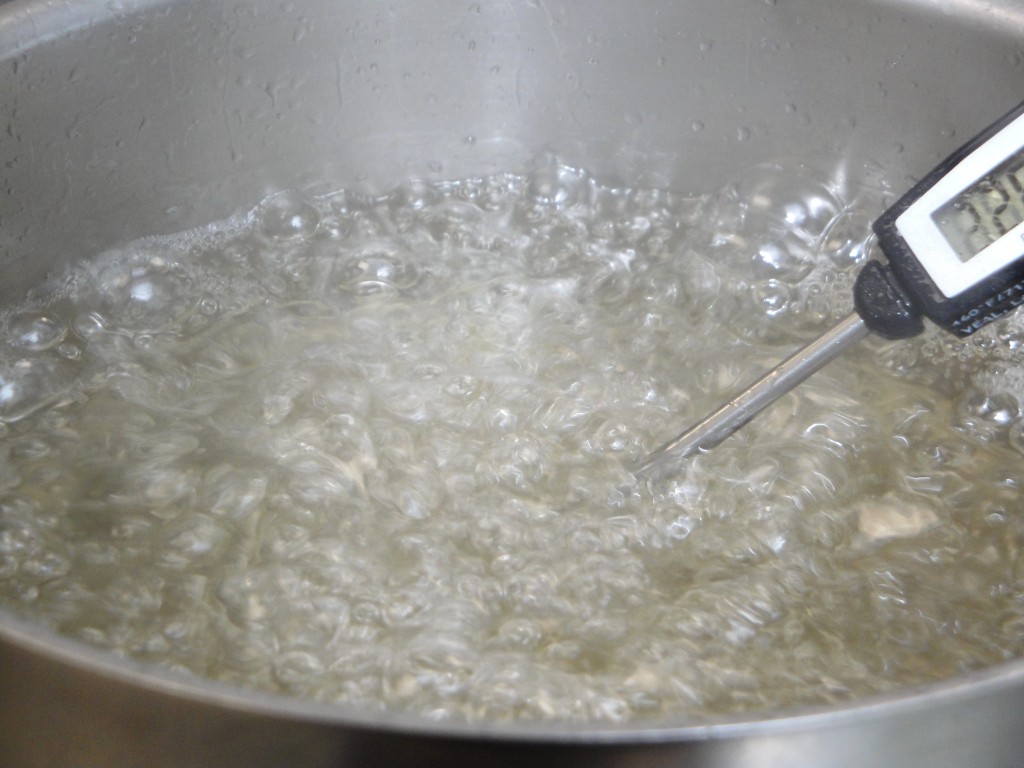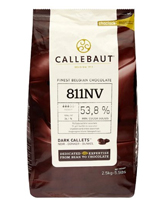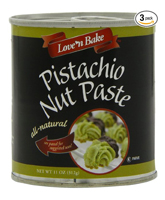Invert sugar- Invert Syrup- Trimoline
An advantage a professional pastry chef has is that certain key ingredients are readily available. One of these ingredients is invert sugar. Although invert sugar is close in chemical composition to honey, it is not found on most grocery store shelves. The good news is that homemade invert sugar is quickly made by anyone. For countless confectionary or baking applications, a corn syrup substitute or replacement can be invert sugar.
Invert sugar is used extensively in confectionary for preparations such as ganache, jellies, fudge, and taffy and in the preparation of sorbets and ice cream. Its ability for controlling crystallization and creating a smoother mouth feel in these products is the main reason why it is used in the first place. Invert sugar is hygroscopic which leads to a reduction of available water in food preparations, resulting in a longer shelf life of countless products. It lowers the spread of bacteria and basically acts as a preservative. The humectant properties of invert sugar are high and will keep products such as fillings for chocolates and fudge much longer moist and tender. Invert sugar also contributes to the Maillard reaction (caramelizing) and consequently will aid the browning process.
Also utilized in certain baked goods like Madeleine’s and brioche where invert sugar is used to increase tenderness and moistness. For all the above mentioned attributes of invert sugar the one I am most excited about is that invert sugar intensifies aromas, especially in sorbet and certain chocolate ganache applications. With so many desirable attributes in confectionary and baking, the question why use invert sugar, is no longer a mystery.

For many years confectioners and pastry chefs have added glucose and or corn syrup into boiled sugar applications to prevent these syrups from crystallizing. In these syrups, substituting corn syrup with invert sugar is something I have done for some time with parallel results.
In confectionary applications such as ganache, invert sugar can be the sole source of sweetener, but in the case of sorbet, gelato, ice cream or cakes only about 5-10% percent of sugar is replaced with invert sugar.
Getting it all together!
Invert sugar has a long shelf life so make a batch and keep it in your refrigerator in a well sealed container for at least 6 months. This way whenever you need to make a pound cake extra moist or control crystallization in gelato or make truffles extra creamy you are set to go!
Invert sugar
Yield: 2 lb 3 oz (1 kilo)
| 4 Cups + 6 Tablespoon | (2 lb 3 oz) | Extra fine granulated sugar | 1 kg |
| 2 cups | (16 fl oz) | Water | 480 ml |
| ¼ Teaspoon | ( ¼ tsp) | Cream of tartar or citric acid | 1 g |
- If you have an induction cook top or an electric stove use these options instead of gas. In a non reactive saucepan stir to a boil the sugar, water and cream of tartar (Or citric acid).
- Once the mixture boils wash away any sugar crystals stuck to the side of the pan with pastry brush dipped in water. Any additional water added to the pan from this process, has no effect on the final outcome.
- On medium heat without stirring boil the mixture to 236°F (114°C). Remove from heat and cover the pan. Let cool at room temperature. Store in a refrigerator. Invert sugar will last at least 6 moths.







Laura,
You may want to reboil it, it will not be harmed by doing so. If it is very liquid it must not have been boiled enough-UNLESS it is liquid because it is still hot! The picture I took was actually refrigerated invert sugar. When students make it I oftentimes see a variety of thickness and some even becomes too hard. (But it will melt away in a cream for ganache or water for sorbet). It is always an issue about boiling it and not reaching the right temperature or using a pot which is too big which makes it difficult to check the temperature. If it is too liquid you basically have too much water in the invert sugar and consequently, whatever you will add it to, you will have too much water in that. Especially not good for a ganache intended for chocolates.
Don’t be afraid of it Laura, give it another try.
Eddy
You were right!! It came out beautifully. Okay, I am SO NOT scared of making invert sugar now. Thank you!! I have a custom application for which I’m using it and it’s perfect.
Hi Chef — I’ve read through both the post and the QnA, but seemed to have missed a crucial point: Why do you consider invert sugar to be better than corn syrup or honey? Aren’t they compositionally very similar?
Hi Pete,
Thank you for your excellent question.
The main reason why I prefer invert sugar is that in many preparations it provides simply an unsurpassed result. In my findings, making an identical ganache-one with corn syrup and one with invert sugar, the one made with invert sugar remains longer elastic and smooth. Invert sugar has a lower AW (Water activity) rating thus lowering the amount of water in preparations. In terms of a ganache for chocolates this is very important since lower water content means a smaller opportunity for bacteria growth.
Honey is a product that I do like, however the flavor is not always desired.
All the best, Eddy.
Hi Chef Eddy,
I plan on brewing an oatmeal stout beer. In my recipe I planned on using inverted brown sugar to improve the fementabilty, but after reading some of the previous posts, it seems using white sugar and a little molasses would be equivelent. Also, I’m assuming the extra moisture in the brown sugar (if I experiment with it anyway) would just increase the boil time to reach the syrup temp. Sound about right?
Thanks,
Jay
Jay,
Brown sugar is indeed made by combining granulated sugar with molasses. I have not made brown sugar invert sugar myself but I do not see why it would not work. Sounds like an exciting project. All the best with it!
Eddy
Hi Chef Eddy,
I am trying to reproduce, to start, a white cake from a long defunct bakery chain with notoriously unsearchable formulas. Somewhere along the line, I learned that invert sugar was a mainstay for the addicting quality of the product list. So, for a white cake I would substitute 5 to 10 % of the granulated with invert syrup? When during the mixing is best for adding the syrup. Similarly for a white frosting, what might be the % of invert and the best time for adding it. Thanks alot/
Joseph,
You are on the right track to make a yellow cake from scratch, nice and tender with invert sugar. Add the invert sugar right before adding the eggs and add between 5-10% of invert sugar in your formula. You may want to test which percentage clearly produces the best results in terms of height, tenderness and moistness. Even make the same recipe with a mix of cake and all purpose.
For the frosting, start with 5 % and see what this gives you. If it does not become too soft and you feel it could benefit of a touch more, do so. In all reality, we bakers and pastry chefs have to do lot’s of testing before we end up with a desired effect.
All the best to your baking endeavors.
Eddy
Hi Chef Eddy,
It seems that with large quantity of sugar/water solution (say 5 kg of sugar)the invert syrup turns darker (more red color), and with less quantity (say 2 kg of sugar) – lighter. Is this normal? or I might be doing something wrong? Also I have heard about adding sodium bicarbonate, is this essential to the process and why? and if so when soda should be added?
Thanks.
Hi Gela,
I’m not sure on the color differences. I never use sodium bicarbonate so I cannot comment.
All the best, Eddy.
I dont make candy, and my sister doesnt do the p.c. so I was trying to help her find a substitute for invert sugar. Thank you by the way. Now jowever shestalking about invertase, is it the same as invert sugar? im confectionary stupid sorry.
thank-you
hi chef Eddy,
would u tell how to make liquid glucose please
Hi Wilson,
I have no idea on how to make glucose from scratch. It is my understanding that you need specialized equipment for making your own glucose. Remeber that in many (not all) applications glucose can be replaced with invert sugar. Certainly invert sugar is sweeter but with some adjustments fantastic results can be obtained.
Eddy.
To Gela,
Baking soda is added to stop the acidity in the inverted sugar. The mix will react (creating little bubbles like alka seltzer) once you add the baking soda.
Cheers
Hello Chef Eddy!
I am a patissier but also a chemist. Therefore I know that the method you use to produce invert sugar is correct, but one thing puzzles me: commercial invert sugar, is opaque white, while the one made at home is clear. I still states on the labels that it just consists of invert sugar (fructose and glucose). Any idea why they do not have the same colour? Do they at least have the same results?
Thans in advance!
Chef,
Great question. I am not sure why the one made in the kitchen is clear versus the one purchased is not (and oftentimes has a slight gritty texture). In my testing, using one purchased and one made by myself, I have obtained the same results in ganache, cakes, breads, sorbet etc. (In the case of sorbet and ganache, I would check to see if there is a difference and I cannot detect one.
I would like to know though why the one made in the atelier is clear.
All the best,
Eddy
Hello Chef,
When you say replace 5-10% of the sugar with invert sugar, do you have to adjust for relative sweetness? It seems to me that replacing some sugar could increase the total sweetness of the finished product, since invert sugar is a saturated solution and is therefore sweeter than sucrose. Is this one of the reasons why a lot of professional ice cream and sorbet recipes use glucose in addition to regular sugar and trimoline? To offset the added sweetness from the trimoline?
Oftentimes, but not always do I adjust. At times I prefer the outcome with simply replacing 5 % of the sugar with invert and leave everything else alone. If I feel it is too sweet and or it is too moist etc then this is what I do:
If I replace 5 % of the sugar with invert sugar, I also reduce the sugar content by 1.5 %.
For example if the recipe calls for 1000 gram of sugar, replace 5% (50 gram) with invert sugar and reduce the sugar by 1.5 %. (15 gram)
Thanks for your question and all the best!
Eddy
Dear Chef Eddy.
I would like to know if I could replace all invert sugar for the granulated sugar in a cocoa brownies recipe. Hence, to acieve a sort of cellophane crust.
Looking forward to hear from you.
Eduardo Madrid M.
Tienda Gourmet de Panes
Medellín, Colombia.
Dear chef Eddy!
I would like to know If I could replace all the regular sugar for invert sugar in a cocoa brownie recipe; hence, to obtain a sort of cellophane crust.
Looking forward to hear from you.
EDUARDO MADRID
Tienda Gourmet de Panes
Medellín, Colombia
Hi Eduardo, Hmmmmm, I would think that your brownies will not properly bake if you replaced the sugar completely with invert sugar. (they will be too moist) However, if you reduced the butter (another moisterizer) then it could be (but I would have to test) possible. If you are making brownies with cocoa powder then certainly you can use a larger amount of invert sugar compared to brownies made with chocolate.
Interesting question and thank you for contacting me.
Eddy.
Hi, Chef
What percentage of invert sugar would you recommend for cookies? And would that percentage (say 1.5 oz invert to 1 lb sugar) replace that amount of sugar in the formula?
Thanks!
Judith
Judith,
To make your cookies more soft and tender you would replace about 5% of sugar with invert sugar. So indeed it simply replaces part of the sugar. If I was you I would do some test and see which percentage of invert sugar you like best. In your particular formula it could be that 3 % invert sugar is the magic number or it could even be 10%.
All the best Judith,
Eddy.
Hi, Chef! I read somewhere that professional pastry chefs brush their cakes with sugar water ten or fifteen minutes before icing them. Is this true? What would this do to the sweetness and moistness that already exists as a result of adding invert sugar? Thanks!
Rachel
I have seen that if you pour your inverted sugar inmediately after it reaches the 236F , the syrup will crystalize. So you must let it cool and undisturbed completly before pour it in a glass jar.
What i have done is once the syrup reaches the 236F , i put the pot cafefully in another big pot that has enought water at room temperature, so the water reaches the first 1/3 of my little pot.
Take in account that 236F is at sea level, adjust that temperature according to your place altitude.
I recently made a batch of Gluten Free sugar cookies with invert sugar from your recipe provided above. The first batch of cookies (all regular sugar) turned out great, but the batch with invert sugar were dry. I live at 5,000 feet. How much % wise should I replace with invert sugar for cookies? I’m needing to extend the life of the product for bake sales. This particular recipe calls for 3 cups of sugar and I added 1/4 cup invert sugar. Thanks so much for your help!
Hi Chef Eddy,
First of all, great webiste! My question is regarding the % of sugar replacement with inverted sugar. When you say % do you mean % by weight or volume? Thank-you for your help 🙂
Hi Nancy,
Thank you!
Replacing invert sugar for sugar is based on weight.
All the best,
Eddy.
Good morning Chef Eddy.
I have a sugar cookie recipe that I’ve worked on for a number of years and recently had the opportunity to meet with a company that is very interested in me supplying them with my cookies. Their concern is that the shelf life needs to be approx. 6 months. I don’t use any preservatives in my recipe and I wondered if I replaced a portion of the granulated sugar with inverted sugar if that would help with the shelf life and if so, how long? I should let you know that I use 1 C of unsalted butter in my recipe – how would I make this work?
Thank you for your kind assistance!
Hi Emma,
Hmmmm, the invert sugar will make the cookie softer for a longer period of time, but I do not know about the six moths time span. Anyone who could help out Emma with this one?
Eddy.
Chef Eddy,
Thank you so much for your quick response. I can research more on the 6-month time span, but in my recipe I call for 2 C of granulated sugar – what would be my ratio of substitution with the invert sugar? Thanks again! Love your website!
Emma
Eddy, I am starting up a gelato/sorbet company and have been trying to figure out a replacement for corn syrup. Thanks so much! And what a great website. Your site is going into my “Favorites”.
Frank
Chef Eddy,
I have prepared this recipe. I don’t have a brush so i covered the pan for 2-3 minutes, and let all the side sugar melt. When the syrup boiled to 240°F i removed it form the stove, and i let it cool completely in its pan. When it was cool it was very thick. I put it in a glass container. The next day the syrup was very hard and crystals appeared inside. At no point did the temperature exceed the 240°F. What am i doing wrong?? Please help
Thank you
John
Hi John,
One of the major causes is using a saucepan which is too big (wide surface) and consequently makes the syrup in the pan too shallow. This oftentimes makes it very hard to get an accurate temperature reading. Another thing can be using a gas stove. I is much harder to make it on gas as opposed to a good electric source. (gas flames surrounding the saucepan works negative for pretty much any type of sugar work)
In many preparations you should still be able to use the invert sugar albeit it is hard.
Please let me know if this helps,
Eddy.
Hi Emma,
What I would do is make 3 batches. One where I replace 5 % of the sugar with invert, another batch with 7.5% and the other with 10%. Bake in the same oven for the same exact time and observe the results.
All the best,
Eddy
Hi there,
I have a chocolate shop and wonder if it is as safe to use the home made invert sugar
as the comercial one
Thanks
Marianne
Thank you Chef for the invert sugar recipe. I had heard that adding invert sugar to cakes makes them more moist..now i am going to try that!! For the first attempt, it turned out perfect… just the same consistency as you have shown in the picture/ as we see it in school.
hi everybody,help me im trying to prepare 1kg of invert sugar but its not good.i need help.
How can I make Honey Grade Invert Syrup?
I make fudge and I boil the sugar and creams at what point should I be adding the invert sugar?
Hi,
You can add invert sugar to fudge as soon as the cream and sugar starts to boil.
My best,
Eddy
Hi: At what temp will a solution of 40% corn syrup and 60% cane sugar begin to invert and how can I minimize the inversion. We are cooking it to 300f and need to keep it above 180 for mixing purposes. It’s typically held at above 215f for 40 min before use. Its then mixed with grains and molded into shape at @ 200f. The grain does have an acid component that can be left out if necessary.
Thanks, Tom
Does anyone have the answer for Tom? I do not know…
Eddy.
Chef Eddy,
It was suggested to me that I use invert sugar in making challah, the idea being that it would create a softer loaf that would not stale as quickly. I was wondering if I should use invert sugar for the entire amount of sweetener. Currently I use honey rather than granulated sugar, but it would be nice to be able to bake a challah without the honey flavor.
Thanks, Joy
Hi Joy,
Most Challah has a honey content of about 10-12 % based upon 100 % flour (Bakers percentage), about 1-1.2 lb of honey to 10-12 lb of flour. Replacing the honey with invert sugar will more then likely work. The reason why I say more then likely is that 10 % of invert sugar is pretty much the limit. However, challah has lots of eggs which provides structure, so I would say it will pretty much work perfect. Please let us know how it cam out.
Eddy.
Hi Chef,
I want to make the invert sugar for you lime marshmallows but I don’t need a whole kilo of the sugar. I think I would end up having to throw most of it out after 6 months. If I halve the recipe will it still turn out okay?
Thanks,
Emma
Hi Emma,
Making a small batch of invert sugar can be very tricky in terms of obtaining the right temperature. In small amount the syrup in the pan will be shallow and most thermometers will have a hard time in giving you an exact temperature. However, you could give it a try. Sugar is not expensive after all.
All the best,
Eddy.
First let me give a big THANK YOU to Chef for this recipe!
To everyone who has experienced crystallization during storage: make sure you do *not* scrape the pot when you’re pouring the room-temperature syrup into your jar/storage container. Be patient and let gravity do the work. You will not get 100% of the syrup, but scraping is a definite no-no.
Also, when you’re weighing out your sugar, watch for any non-sugar “specks” and eliminate them before beginning the cooking process. (This is easy to do if you pour the sugar, slowly but steadily, out of the bag or container onto the scale and simply watch the accumulating pile for anything that isn’t obviously a sugar grain.)
Anything foreign in your syrup will act as a “seed” for the syrup to crystallize around.
Good luck to all, and thank you again Chef!
Marc,
Thank you for your important pointers.
All the best! Eddy
in which cases is crystallization an issue? in ice cream?
i just made a 1/4 batch, and was certainly not the most careful about the procedure, and after it had cooled the surface was coated in a crispy shell – i assume this would just blend in to whatever recipe it was being used in…